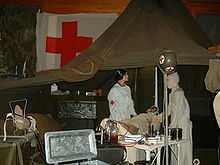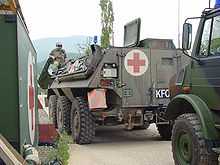Military medicine

_(16005170175).jpg)
_aboard_the_Military_Sealift_Command_(MSC)_hospital_ship_USNS_Mercy_(T-AH_19)%2C_perform_a_cleft_lip_surgery.jpg)
_Hospital_ship_USNS_Mercy_(T-AH_19)%2C_anchored_off_of_the_coast_of_Jolo_City.jpg)
_from_the_212th_Mobile_Army_Surgical_Hospital_(MASH)_Miesau%2C_Germany%2C_and_Dilmurod_local_national_Interpreter.jpg)

.jpg)
The term military medicine has a number of potential connotations. It may mean:
- A medical specialty, specifically a branch of occupational medicine attending to the medical risks and needs (both preventive and interventional) of soldiers, sailors and other service members. This disparate arena has historically involved the prevention and treatment of infectious diseases (especially tropical diseases), and, in the 20th Century, the ergonomics and health effects of operating military-specific machines and equipment such as submarines, tanks, helicopters and airplanes. Undersea and aviation medicine can be understood as subspecialties of military medicine, or in any case originated as such. (The American Board of Medical Specialties does not, however, certify or recognize a specialty or subspecialty of “military medicine”.)
- The planning and practice of the surgical management of mass battlefield casualties and the logistical and administrative considerations of establishing and operating combat support hospitals. This involves military medical hierarchies, especially the organization of structured medical command and administrative systems that interact with and support deployed combat units. (See Battlefield medicine.)
- The administration and practice of health care for military service members and their dependents in non-deployed (peacetime) settings. This may (as in the United States) consist of a medical system paralleling all the medical specialties and sub-specialties that exist in the civilian sector. (See also Veterans Health Administration which serves U.S. veterans.)
- Medical research and development specifically bearing upon problems of military medical interest. Historically, this encompasses all of the medical advances emerging from medical research efforts directed at addressing the problems encountered by deployed military forces (e.g., vaccines or drugs for soldiers, medical evacuation systems, drinking water chlorination, etc.) many of which ultimately prove important beyond the purely military considerations that inspired them.
Military medical personnel engage in humanitarian work and are "protected persons" under international humanitarian law in accordance with the First and Second Geneva Conventions and their Additional Protocols, which established legally binding rules guaranteeing neutrality and protection for wounded soldiers, field or ship's medical personnel, and specific humanitarian institutions in an armed conflict. International humanitarian law makes no distinction between medical personnel who are members of the armed forces (and who hold military ranks) and those who are civilian volunteers. All medical personnel are considered non-combatants under international humanitarian law because of their humanitarian duties, and they may not be attacked and not be taken as prisoners of war; hospitals and other medical facilities and transports identified as such, whether they are military or civilian, may not be attacked either. The red cross, the red crescent and the red crystal are the protective signs recognised under international humanitarian law, and are used by military medical personnel and facilities for this purpose. Attacking military medical personnel, patients in their care, or medical facilities or transports legitimately marked as such is a war crime. Likewise, misusing these protective signs to mask military operations is the war crime of perfidy. Military medical personnel may be armed, usually with service pistols, for the purpose of self defense or the defense of patients.
Historical significance
The significance of military medicine for combat strength goes far beyond treatment of battlefield injuries; in every major war fought until the late 19th century disease claimed more soldier casualties than did enemy action. During the American Civil War (1860–65), for example, about twice as many soldiers died of disease as were killed or mortally wounded in combat.[1] The Franco-Prussian War (1870–71) is considered to have been the first conflict in which combat injury exceeded disease, at least in the German coalition army which lost 3.47% of its average headcount to combat and only 1.82% to disease.[2] In new world countries, such as Australia, New Zealand, the United States and Canada, military physicians and surgeons contributed significantly to the development of civilian health care.[3]
Military surgeon
In many English-speaking countries the military title of surgeon is applied to any medical practitioner, due to the historical evolution of the term. The title of Surgeon General continues to exist in some countries for both senior military medical officers and senior government public health officers.
Military medicine by country
North America
Canada
United States
- Military Health System
- Military Medicine, academic journal
- TRICARE
- Uniformed Services University of the Health Sciences
- Henry M. Jackson Foundation for the Advancement of Military Medicine
- Defense Health Agency
- Joint Task Force National Capital Region/Medical
- Executive Order 13139
- 68W, the "combat medic"
- Army Medical Department
- Battalion Aid Stations
- Borden Institute
- Combat Support Hospital
- Fort Detrick
- Fort Sam Houston
- Forward Surgical Teams
- Medical Corps (United States Army)
- Nurse Corps (United States Army)
- Mobile Army Surgical Hospital
- Surgeon General of the U.S. Army
- Textbook of Military Medicine (1989–2007), published by the U.S. Army
- U.S. Army Dental Command
- U.S. Army Medical Command
- Surgeon General of the U.S. Navy
- U.S. Navy Dental Corps
- U.S. Navy Hospital Corpsman
- U.S. Navy Medical Corps
- U.S. Navy Medical Service Corps
- U.S. Navy Nurse Corps
- Naval Medical Center San Diego
- Naval Medical Center Portsmouth
- National Naval Medical Center
- Hospital ship
- Diving medicine
- Surgeon General of the U.S. Air Force
- U.S. Air Force Medical Service
- Aeromedical evacuation
- Aviation medicine
Europe
France
Belgium
Germany
- Bundeswehr Joint Medical Service
Russia
- Kirov Military Medical Academy (founded in 1798)
- Military academies in Russia#Kuybyshev Military Medical Academy
- Military Medical Business, academic journal
- Museum of Military Medicine
Serbia
United Kingdom
- Medical Assistant (Royal Navy)
- Royal Navy Medical Service
- Queen Alexandra's Royal Naval Nursing Service
- Queen Alexandra's Royal Army Nursing Corps
- Princess Mary's Royal Air Force Nursing Service
- Army Medical Services
- Royal Army Medical Corps
- RAF Medical Services
- Surgeon-General (United Kingdom)
- Defence Medical Services
Other regions
Australia
- Australian Army Medical Units, World War I
- Royal Australian Army Medical Corps
- Royal Australian Army Nursing Corps
Israel
- Logistics, Medical, and the Centers Directorate
- Medical Corps (Israel)
South Africa
Vietnam
- Vietnam Military Medical University (Học Viện Quân Y) in Hanoi
India
See also
- casualty evacuation (CASEVAC)
- combat medic
- combat stress reaction
- field hospital
- flight medic
- flight surgeon
- history of military nutrition in the United States
- medical corps
- medical evacuation (MEDEVAC)
- Medical Service Corps
- military ambulance
- military medical ethics
- military nurse
- military psychiatrist
- military psychiatry
- triage
References
- ↑ McPherson, James M. (1988). Battlecry of Freedom. Ballantine Books, New York. ISBN 0-345-35942-9., p. 485
- ↑ Brockhaus' Konversations-Lexikon; 14th ed., Leipzig, Berlin and Vienna 1894; Vol. 8, p. 939.
- ↑ Vivian Charles McAlister. "Origins of the Canadian School of Surgery" Canadian Journal of Surgery (2007) 50 (5) : 357-363. Available at:
External links
| Wikimedia Commons has media related to Military medicine. |
U.S. military medicine
- Military Medicine related links from USAF Air University
- Association of Military Surgeons of the United States (AMSUS)
- Military Medicine Through Time. Life and Death in the War Zone | NOVA | PBS
- The Borden Institute Homepage
- Military Medicine Documents at USU Archive
- U.S. Army Preventive Medicine news archive from the 7th Infantry Division (Light) Panorama weekly newspaper 1988.
- Virtual Naval Hospital - a digital library of military medicine and humanitarian medicine
- http://www.ipernity.com/doc/57114/5652001/in/keyword/487917/self (military medical exams)
- (China: military medical tests)
Australian military medicine
International Magazine for Military Medicine
- MCIF MEDICAL CORPS INTERNATIONAL FORUM International Magazine for Military Medicine
NATO Centre of Excellence for Military Medicine